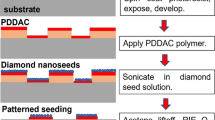Abstract
Irradiation of metallic surfaces using ultra-short pulse laser results in a dual-scale structure. While metallic surfaces are superhydrophilic immediately after laser irradiation, prolonged exposure to air renders surfaces superhydrophobic due to surface reactions and deposition of carbonaceous materials onto the surface. In this work, we have fabricated a paraboloid microstructure, which is analyzed thermodynamically through the use of the Gibbs free energy to obtain the equilibrium contact angle and contact angle hysteresis. The effects of the geometrical details on maximizing the superhydrophobicity of the nanopatterned surface are also discussed in an attempt to design surfaces with desired and/or optimum wetting characteristics.










Similar content being viewed by others
Abbreviations
- A p :
-
Pillar area
- A v :
-
Area between pillars
- D :
-
Base diameter of paraboloid
- F :
-
Gibbs free energy per unit length of contact line
- f sl :
-
Fraction of projected solid area in contact with liquid
- H :
-
Pillar height
- H 1 :
-
Penetrated liquid height in the composite state
- L i :
-
Droplet width at a given (point) state
- l la :
-
Arc length of droplet in contact with air
- l ls :
-
Arc length difference of liquid–solid contact line for two given states
- R :
-
Radius of curvature of the droplet profile
- r f :
-
Roughness factor
- P :
-
Base-to-base distance of pillars (pitch)
- α :
-
Slope angle
- γ la :
-
Liquid–air interfacial tension
- γ sa :
-
Solid–air interfacial tension
- γ sl :
-
Solid–liquid interfacial tension
- θ app :
-
Apparent contact angle
- θ CB :
-
Cassie–Baxter state contact angle
- θ flat :
-
Intrinsic contact angle
- θ i :
-
Apparent contact angle at a given ( point i ) state of the drop
- θ w :
-
Wenzel state contact angle
References
Gao L, McCarthy TJ (2009) Langmuir 25:14100
Ma M, Hill RM (2006) J Curr Opin Colloid Interface Sci 11:193
Liu B, He Y, Fan Y, Wang X (2006) Macromol Rapid Comm 27:1859
Otten A, Herminghaus S (2004) Langmuir 20:2405
Carre A, Mittal KL (2009) Superhydrophobic surfaces. VSP/Brill, Leiden
Groenendjik MNW (2008) Laser Tech J 3:44
Goncalves G, Marques PAAP, Trinadade T, Neto CP, Gandini A (2008) J Colloid Interface Sci 324:42
Balu B, Breedveld V, Hess DW (2008) Langmuir 24:4785
Barthlott W, Neinhuis C (1997) Planta 202:1
Johnson RE Jr, Dettre RH (1964) Adv Chem Ser 43:112
Shuttleworth R, Bailey GLJ (1948) Discuss Faraday Soc 3:16
Li W, Amirfazli A (2005) J Colloid Interface Sci 292:195
Amirfazli A (2007) Adv Colloid Interface Sci 132:51
Bormashenko E, Pogreb R, Stein T, Whyman G, Erlich M, Musin A, Machavariani V, Aurbach D (2008) Phys Chem Chem Phys 10:4056
Bormashenko E, Pogreb R, Whyman G, Erlich M (2007) Langmuir 23:6501
Jung YC, Bhushan B (2009) Langmuir 25:9208
Liu B, Lange FF (2006) J Colloid Interface Sci 298:899
Bormashenko E, Stein T, Whyman G, Bormashenko Y, Pogreb R (2006) Langmuir 22:9982
Bormashenko E, Stein T, Whyman G, Pogreb R, Sutovsky S, Danoch Y, Shoham Y, Bormashenko Y, Sorokov B, Aurbach D (2008) J Adhes Sci Tech 22:379
Marmur A (2008) Langmuir 24:7573
Baldacchini T, Carey JE, Zhou M, Mazur E (2006) Langmuir 22:4917
Zorba V, Persano L, Pisignano D, Athanassiou A, Stratakis E, Cingolani R, Tzanetakis P, Fotakis C (2006) Nanotechnology 17:3234
Zorba V, Stratakis E, Barberoglou M, Spanakis E, Tzanetakis P, Anastasiadis SH, Fotakis C (2008) Adv Mater 20:4049
Barberoglou M, Zorba V, Stratakis E, Spanakis E, Tzanetakis P, Anastasiadis AH, Fotakis C (2009) Appl Surf Sci 255:5425
Kietzig AM, Hatzikiriakos SG, Englezos P (2009) Langmuir 25:4821
Kietzig AM, Hatzikiriakos SG, Kietzig PA-M, Mirvakili MN, Kamal S, Englezos P, Hatzikiriakos SG (2011) J Adhes SciTech 25:2789
Marmur A (2006) Soft Matter 2:12
Krasovitski B, Marmur A (2005) Langmuir 21:3881
Lafuma A, Que’re’ D (2003) Nat Mater 2:457
Author information
Authors and Affiliations
Corresponding author
Additional information
This article is part of the Topical Collection on Contact Angle Hysteresis
Rights and permissions
About this article
Cite this article
Moradi, S., Englezos, P. & Hatzikiriakos, S.G. Contact angle hysteresis: surface morphology effects. Colloid Polym Sci 291, 317–328 (2013). https://doi.org/10.1007/s00396-012-2746-3
Received:
Accepted:
Published:
Issue Date:
DOI: https://doi.org/10.1007/s00396-012-2746-3




